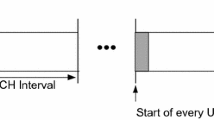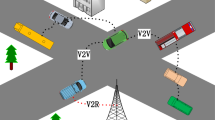Abstract
In this work, a new routing protocol has been exclusively designed for reducing the generated overhead of beacon-based routing at the road segments of city environments in Vehicular Ad hoc Network. The main objective is to reduce the resulted overhead from the periodic exchange of beacon messages while preserving the same network awareness. To do so, the proposed protocol exploits the availability of two directional antennas to decrease the size of the beacons instead of their number. In particular, the proposed protocol modifies greedy forwarding at the road segments so the distance between a packet holder and its direct neighbors can be calculated using the neighbors’ received power instead of their current geographical position. Results have shown a decrease in both control and beacon overheads of the proposed protocol compared to other beacon-based protocols.








Similar content being viewed by others
References
Weigle, M. C., & Olariu, S. (2009). Vehicular networks: From theory to practice. Boca Raton: Chapman and Hall.
Li, G., Boukhatem, L., & Martin, S. (2015). An intersection-based QoS routing in vehicular ad hoc networks. Mobile Networks and Applications, 20(2), 268–284.
Wang, H., Tan, G., & Yang, J. (2012). An improved VANET intelligent forward decision-making routing algorithm. Journal of Networks, 7(10), 1546–1553.
Alsharif, N., Céspedes, S., & Shen, X. (2013). iCAR: Intersection-based connectivity aware routing in vehicular ad hoc networks. In Proceedings of the IEEE international conference on communications (ICC) (pp. 1736–1741).
Naumov, V., & Gross, T. R. (2007). Connectivity-aware routing (CAR) in vehicular ad-hoc networks. In Proceedings of the 26th IEEE international conference on computer communications (pp. 1919–1927).
Lochert, C., Mauve, M., Füßler, H., & Hartenstein, H. (2005). Geographic routing in city scenarios. ACM SIGMOBILE Mobile Computing and Communications Review, 9(1), 69–72.
Dhurandher, S. K., Obaidat, M. S., Bhardwaj, D., & Garg, A. (2012). GROOV: A geographic routing over VANETs and its performance evaluation. In Proceedings of global communications conference (GLOBECOM) (pp. 1670–1675).
Chen, C., Jin, Y., Pei, Q., & Zhang, N. (2014). A connectivity-aware intersection-based routing in VANETs. EURASIP Journal on Wireless Communications and Networking, 2014(1), 1–16.
Nakorn, K. N., Ji, Y., & Rojviboonchai, K. (2014). Bloom filter for fixed-size beacon in VANET. In Proceedings of IEEE 79th vehicular technology conference (VTC) (pp. 1–5).
Giudici, F., & Pagani, E. (2005). Spatial and traffic-aware routing (STAR) for vehicular systems. Lecture Notes in Computer Science, 3726, 77.
Heissenbüttel, M., Braun, T., Wälchli, M., & Bernoulli, T. (2007). Evaluating the limitations of and alternatives in beaconing. Ad Hoc Networks, 5(5), 558–578.
Li, H., & Xu, Z. (2018). Routing protocol in VANETs equipped with directional antennas: Topology-based neighbor discovery and routing analysis. Wireless Communications and Mobile Computing, 2018, 1–13.
Ren, Z., Li, W., Wu, S., Yang, Q., & Chen, L. (2009). Location security in geographic ad hoc routing for VANETs. In Proceedings of the international conference on ultra modern telecommunications & workshops (ICUMT’09) (pp. 1–6).
Rubin, I., Lin, Y. -Y., Baiocchi, A., Cuomo, F., & Salvo, P. (2013). Vehicular backbone networking protocol for highway broadcasting using directional antennas. In Proceedings of GLOBECOM workshops (pp. 4414–4419).
Kim, B., Cho, K., & Nam, C. (2014). A survey on qualitative analysis of directional VANET MAC protocols. International Journal of Contents, 10(2), 9–17.
Xie, X., Wang, F., Wang, H., & Li, K. (2008). Adaptive multi-channel MAC protocol for dense VANET using directional antennas. In Proceedings of the second international conference on future generation communication and networking (pp. 398–401).
Curiac, D.-I. (2016). Wireless sensor network security enhancement using directional antennas: State of the art and research challenges. Sensors, 16(4), 488.
Rappaport, T. S. (1996). Wireless communications: Principles and practice. V (Vol. 2). Upper Saddle River: Prentice Hall (PTR).
Rao, S. A., Pai, M., Boussedjra, M., & Mouzna, J. (2008). GPSR-L: Greedy perimeter stateless routing with lifetime for VANETS. In Proceedings of ITS telecommunications (pp. 299–304).
Liu, G., Lee, B.-S., Seet, B.-C., Foh, C.-H., Wong, K.-J., & Lee, K.-K. (2004). A routing strategy for metropolis vehicular communications. In: Information networking technologies for broadband and mobile networks (pp. 134–143).
Krajzewicz, D., Erdmann, J., Behrisch, M., & Bieker, L. (2012). Recent development and applications of SUMO-simulation of urban mobility. International Journal on Advances in Systems and Measurements, 5(3&4), 128–138.
Haklay, M., & Weber, P. (2008). Openstreetmap: User-generated street maps. IEEE Pervasive Computing, 7(4), 12–18.
Author information
Authors and Affiliations
Corresponding author
Additional information
Publisher's Note
Springer Nature remains neutral with regard to jurisdictional claims in published maps and institutional affiliations.
Rights and permissions
About this article
Cite this article
Zahedi, K., Zahedi, Y. & Ismail, A.S. Using Two Antennas to Reduce the Generated Overhead of Beacon-Based Protocols in VANET. Wireless Pers Commun 104, 1343–1354 (2019). https://doi.org/10.1007/s11277-018-6086-6
Published:
Issue Date:
DOI: https://doi.org/10.1007/s11277-018-6086-6




